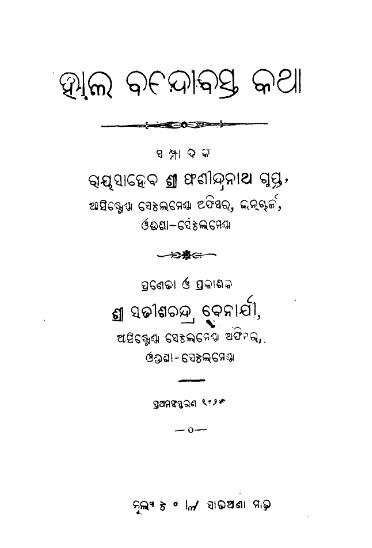Published in 1925, Hal Bandobasta Katha by Satish Chandra Banarji stands as a significant contribution to Odia literature, particularly in the realm of educational texts focused on general knowledge. This book not only serves as a repository of information but also reflects the socio-cultural and agricultural landscape of Odisha during the early 20th century.
Hal Bandobasta Katha translates to The Tales of Agricultural Implements, and the book is structured around various topics related to agriculture, rural life, and the tools that facilitate farming practices. Banarji uses a narrative style that combines storytelling with factual information, making learning both engaging and informative. His work is intended to educate readers about the intricacies of agriculture while fostering a deeper appreciation for the agrarian lifestyle that defines much of Odisha’s culture.
At the core of Hal Bandobasta Katha is the importance of agriculture to the Odia way of life. Banarji delves into the different farming implements, practices, and techniques that have been used by farmers in Odisha. He introduces readers to traditional tools like the plough (hal), sickle (dahi), and other essential farming equipment. Each chapter not only describes these tools but also shares stories about their significance in the farming community, reflecting the bond that exists between people and the land they cultivate.
Through vivid descriptions and relatable anecdotes, Banarji brings to life the day-to-day realities of agricultural work. His writing serves to educate readers on the value of agriculture as the backbone of Odisha’s economy, showcasing its impact on the rural populace and their livelihoods.
Beyond mere facts about agricultural tools and practices, “Hal Bandobasta Katha” captures the rich cultural heritage of Odisha. Banarji weaves in folklore, traditions, and local customs associated with farming, reflecting how agriculture shapes community life. From seasonal festivals celebrating harvests to rituals performed for favorable weather, the book highlights the integral role of farming in the social fabric of Odia society.
By documenting these cultural elements, Banarji preserves the rich heritage of rural Odisha, providing contemporary readers with a window into the traditions and values that persist today. His work resonates with those interested in understanding the past and the enduring connection between culture and agriculture.
Hal Bandobasta Katha serves as an excellent educational resource, particularly for students and aspiring farmers. Banarji aims to equip readers with knowledge that is practical and applicable. His systematic approach to presenting information makes complex agricultural concepts accessible and understandable, ensuring that the lessons offered are both informative and engaging.
The book encourages readers to appreciate the environment and the importance of sustainable farming practices. By understanding the tools and techniques of agriculture, readers are empowered to contribute positively to their communities and environments.
Books Info
| Books name | Hal Bandobasta Katha / ହାଲ ବନ୍ଦୋବସ୍ତ କଥା |
| Author | Satish Chandra Banarji |
| No Of pages | 79 |
| Publisher | Sri Satishchandra benarji |
| Publication | 1925 |
| Printed At | NA |
| Distributor | NA |

